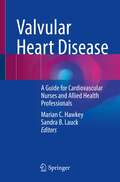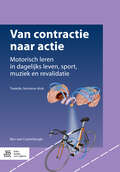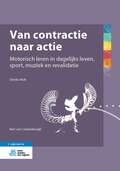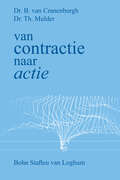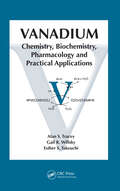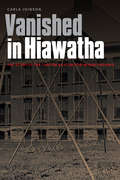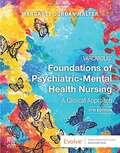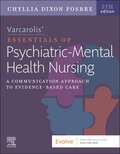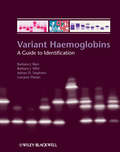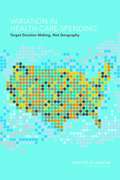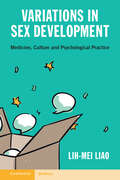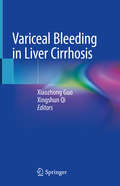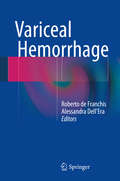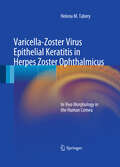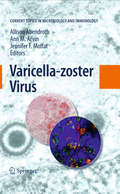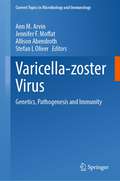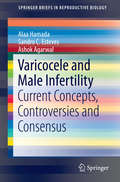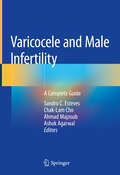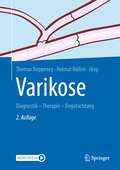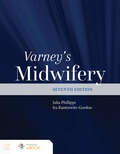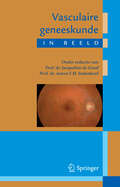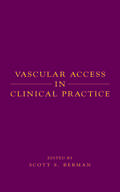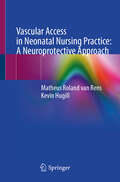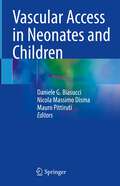- Table View
- List View
Valvular Heart Disease: A Guide for Cardiovascular Nurses and Allied Health Professionals
by Marian C. Hawkey Sandra B. LauckThis book serves as the “go-to” resource for cardiovascular nurses and other health care practitioners involved in the care of patients with acquired valvular heart disease. It includes unique information about heart valve anatomy and pathophysiology, the complexity of clinical presentations and diagnostic evaluation, patient education and shared decision-making, surgical and transcatheter treatment options, and transition to palliative care. The content focuses primarily on the specialized care of patients with aortic stenosis and regurgitation, and mitral and tricuspid regurgitation. In addition, this unique resource provides timely information to guide a patient-centred and team-driven approach that reflects contemporary and innovative practice in the management of valvular heart disease. The essential topics of strengthening the multidisciplinary Heart Team and programmatic processes of care, the priorities for nursing care, and the multifactorial challenges of managing this complex patient population are explored in detail. Importantly, this resource aims to support all clinicians who are involved in the various timepoints of patients’ full trajectory of care, from their evaluation pathway, admissions for treatment, and long term follow-up. Clinicians require contemporary knowledge and evidence to guide their practice, provide appropriate care for this complex patient population, and contribute to the advancement of practice. To date, there has been little emphasis placed on the management of valvular heart disease in cardiovascular nursing and allied health curriculum. This book fills this gap and addresses the pressing need for a user-friendly resource to guide the care for this growing population in a rapidly changing clinical environment. The editors are international leaders in the care and management of patients with acquired valvular heart disease and program development. They are widely recognized for their pioneering role in shaping the way we care for these patients.
Van contractie naar actie
by Ben Van CranenburghDit boek bespreekt de belangrijkste theorieën over het leren van motorische vaardigheden met het oog op de mogelijke toepassingen in sport, muziek en revalidatie. Het is bedoeld voor ieder die zich bezighoudt met het aanleren van motorische vaardigheden, professionals zoals sport-, muziek- en dansleraren , voor paramedici (fysiotherapeuten, ergotherapeuten en oefentherapeuten) maar zeker ook voor de ontwikkelde leek die als musicus, sporter of patiënt geïnteresseerd is in de mechanismen achter het leren van motorische vaardigheden.Mensen zijn tot indrukwekkende motorische prestaties in staat. De snelheid en nauwkeurigheid van een tennisservice, de vingervlugheid en fingerspitzengefühl van de musicus, de salto’s van de kunstschaatser en turner zijn verbazingwekkend. En dat geldt zelfs voor doodgewone dagelijks leven activiteiten zoals fietsen, timmeren of aardappels schillen. Sommige patiënten met hersenbeschadiging (bijv. beroerte) herstellen goed, andere niet, waarom? Goed om daar eens bij stil te staan.Motorisch leren is ondenkbaar zonder hersenen. Er niet één hersengebied voor motoriek, maar talrijke hersengebieden blijken betrokken. Dit strookt geheel met het huidige inzicht dat het leren van motorische vaardigheden onlosmakelijk verbonden is met sensoriek, emoties en cognitie.Er is zeker niet één superieure leermethode, maar er bestaat een uitgebreid palet aan mogelijke leerstrategieën waaruit weloverwogen gekozen kan worden op basis van iedere individuele situatie. Aan de hand van vele uitgewerkte praktische voorbeelden op het gebied van sport, muziek en revalidatie, laat het boek zien dat de wetenschappelijke inzichten over motorisch leren hun directe toepassing in de praktijk kunnen hebben.
Van contractie naar actie: Motorisch leren in dagelijks leven, sport, muziek en revalidatie
by Ben van CranenburghDit boek bespreekt de belangrijkste theorieën over het leren van motorische vaardigheden met het oog op de mogelijke toepassingen in sport, muziek en revalidatie. Het is bedoeld voor ieder die zich bezighoudt met het aanleren van motorische vaardigheden. Denk aan professionals zoals sport-, muziek- en dansleraren, of paramedici als fysiotherapeuten, ergotherapeuten en oefentherapeuten. Maar het is zeker ook waardevol voor de ontwikkelde leek die als musicus, sporter of patiënt geïnteresseerd is in de mechanismen achter het leren van motorische vaardigheden. Theorieën over motorisch leren en de rol die de hersenen daarbij spelen, zijn nadrukkelijk in beweging Van contractie naar actie. Motorisch leren in dagelijks leven, sport, muziek en revalidatie maakt deel uit van de zesdelige serie ‘Toegepaste neurowetenschappen’. Deze derde editie is geactualiseerd. Er zijn onder andere praktisch bruikbare ideeën toegevoegd over belangrijke aspecten zoals talent, ‘mindset’ en ‘mental effort’. Mensen zijn tot indrukwekkende motorische prestaties in staat. De snelheid en nauwkeurigheid van een tennisservice, de vingervlugheid en het Fingerspitzengefühl van de musicus, de salto’s van de kunstschaatser en turner zijn verbazingwekkend. En dat geldt zelfs voor doodgewone activiteiten uit het dagelijks leven zoals fietsen, timmeren of aardappels schillen. Sommige patiënten met hersenbeschadiging (bijv. een beroerte) herstellen goed, andere niet – de vraag is waarom? Goed om ook daar eens bij stil te staan. Motorisch leren is ondenkbaar zonder hersenen. De motoriek wordt niet aangestuurd vanuit één bepaald hersengebied, maar er blijken talrijke hersengebieden bij betrokken te zijn. Dit strookt geheel met het huidige inzicht dat het leren van motorische vaardigheden onlosmakelijk verbonden is met sensoriek, emoties en cognitie. Er is zeker niet één superieure leermethode, maar er bestaat een uitgebreid palet aan mogelijke leerstrategieën waaruit weloverwogen gekozen kan worden op basis van iedere individuele situatie. Aan de hand van vele uitgewerkte praktische voorbeelden op het gebied van sport, muziek en revalidatie laat het boek zien dat de wetenschappelijke inzichten over motorisch leren hun directe toepassing in de praktijk kunnen hebben. Ben van Cranenburgh studeerde geneeskunde in Amsterdam en was als wetenschappelijk medewerker verbonden aan onder meer het Nederlands Centraal Instituut voor Hersenonderzoek en het Revalidatie Centrum Amsterdam. In 1987 richtte hij het Instituut voor toegepaste neurowetenschappen (stichting ITON) op, waar hij tot op heden werkzaam is. De stichting ITON biedt nascholingscursussen aan op het gebied van de toegepaste Neurowetenschappen.
Van contractie naar actie: Theorieen over motoriek en toepassingen in sport, therapie en pedagogiek
by B. van CranenburghIedere student breekt zich wel eens het hoofd over het juiste gebruik van de medische terminologie. Gelukkig is er nu het "Groene Boekje" voor medische termen! In dit boekje: de logica van de medische taal door deze te ontleden tot stamwoorden en voor- en achtervoegsels, een opsomming van regels die gelden voor de uitspraak van medische termen en het gebruik van enkel- en meervoud. Ook worden andere relevante (taalkundige) aspecten beschreven. Aan de orde komen o.a. het gelegitimeerd gebruik van Nederlandse termen, het liggend streepje, afkortingen, de belangrijkste verschillen tussen oude en nieuwe spelling, medische eponiemen, eenheden en hun voorvoegsels. Achterin is een alfabetische lijst opgenomen met een groot aantal medische termen.
Vanadium
by Hitoshi MichibataThe publication of Vanadium: Biochemical and Molecular Biological Approaches is particularly timely as it exactly coincides with the centennial anniversary of the discovery of vanadium by Professor Henze, in the blood cells of an ascidian (tunicate) collected in Gulf of Naples in 1911. Vanadium, atomic number 23, covers a wide range of oxidation states (from -2 to +5) and has unpaired electrons. Depending on these properties, a wide variety of enzymes and compounds containing vanadium have been found and the biochemical behaviour of vanadium has been investigated extensively. This monograph provides not only the basic properties and recent advances of vanadium chemistry but also presents recent topics on hyper-accumulators of vanadium, enzymatic roles of vanadium, biochemical functions of vanadium and medicinal functions of vanadium, which have been discovered by Biochemical and Molecular Biological Approaches. Vanadium: Biochemical and Molecular Biological Approaches is aimed at pure and applied chemists, biochemists, pharmaceutical and medical scientists.
Vanadium: Chemistry, Biochemistry, Pharmacology and Practical Applications
by Alan S. Tracey Gail R. Willsky Esther S. TakeuchiThe first comprehensive resource on the chemistry of vanadium, Vanadium: Chemistry, Biochemistry, Pharmacology, and Practical Applications has evolved from over a quarter century of research that concentrated on delineating the aqueous coordination reactions that characterize the vanadium(V) oxidation state. The authors distill information o
Vanished in Hiawatha: The Story of the Canton Asylum for Insane Indians
by Carla JoinsonBegun as a pork-barrel project by the federal government in the early 1900s, the Canton Asylum for Insane Indians quickly became a dumping ground for inconvenient Indians. The federal institution in Canton, South Dakota, deprived many Native patients of their freedom without genuine cause, often requiring only the signature of a reservation agent. Only nine Native patients in the asylum’s history were committed by court order. Without interpreters, mental evaluations, or therapeutic programs, few patients recovered. But who cared about Indians and what went on in South Dakota? After three decades of complacency, both the superintendent and the city of Canton were surprised to discover that someone did care and that a bitter fight to shut the asylum down was about to begin. In this disturbing tale, Carla Joinson unravels the question of why this institution persisted for so many years. She also investigates the people who allowed Canton Asylum’s mismanagement to reach such staggering proportions and asks why its administrators and staff were so indifferent to the misery experienced by patients.Vanished in Hiawatha is the harrowing tale of the mistreatment of Native American patients at a notorious insane asylum whose history helps us to understand the broader mistreatment of Native peoples under forced federal assimilation in the nineteenth and early twentieth centuries.
Varcarolis' Foundations of Psychiatric-Mental Health Nursing: A Clinical Approach
by Margaret Jordan HalterPrepare for psychiatric nursing care with this comprehensive, evidence-based text! Varcarolis' Foundations of Psychiatric-Mental Health Nursing: A Clinical Approach, 9th Edition makes it easy to understand the complexities of psychiatric disorders and how to provide quality mental and behavioral health care. Clinical chapters follow the nursing process framework and progress from theory to application, preparing you for practice with real-world examples. Other notable features include illustrated explanations of the neurobiology of disorders, DSM-5 criteria for major disorders, and nursing care plans. From clinical nurse specialist and lead author Dr. Margaret Jordan Halter, this bestselling text includes new Next Generation NCLEX® content to prepare you for success on your PMHN certification exam.
Varcarolis’ Essentials of Psychiatric Mental Health Nursing: A Communication Approach to Evidence-Based Care
by Chyllia D Fosbre MSN RN PMHNP-BCVarcarolis’ Essentials of Psychiatric-Mental Health Nursing: A Communication Approach to Evidence Based Care, 5th Edition provides a concise, easy-to-understand guide to today’s leading psychiatric theories and therapeutic modalities. Emphasizing evidence-based care, the book balances coverage of scientifically based treatment approaches with insights into effective communication skills, so you will be prepared to offer the best possible care when you enter practice. Written by nursing expert Chyllia D. Fosbre, this edition adds new Next Generation NCLEX® (NGN) examination-style case studies to help you develop critical thinking skills and prepare for the NGN exam.
Variant Haemoglobins: A Guide to Identification
by Barbara J. Bain Adrian Stephens Lorraine Phelan Barbara WildVariant Haemoglobins – A Guide to Identification is based on the premise that any single diagnostic technique offers only a very provisional identification of a variant haemoglobin. In routine diagnostic practice two techniques are needed as a minimum, with the results being interpreted in the light of the clinical details, blood count, blood film and ethnic origin. This book covers 150 normal and variant haemoglobins that have been studied and carefully documented. Variant Haemoglobins has four introductory chapters followed by an invaluable atlas. The introductory chapters cover the genetics of haemoglobin synthesis the principles of tests employed for identification common haemoglobins of major clinical or diagnostic importance thalassaemias and related conditions The atlas section comprises 170 full colour pages in which each variant haemoglobin or combination of haemoglobins is illustrated by cellulose acetate electrophoresis at alkaline pH, agarose gel electrophoresis at acid pH, isoelectric focusing and one or more HPLC traces. For ease of reference, the atlas pages are arranged according to the retention time of each haemoglobin on HPLC, this becoming increasingly the primary technique employed in haemoglobin identification. Bringing a mix of necessary scientific expertise and clinical knowledge, each author has more than 30 years experience in the diagnosis of variant haemoglobins. Providing otherwise unavailable information, this unique and practical guide is illustrated with over 700 high quality colour digital images plus flow charts and line diagrams covers common and important haemoglobin variants, in addition to many rarer ones is an essential reference source for diagnosis in the haematology laboratory A remarkably useful book, Variant Haemoglobins will be valuable for haematopathologists, clinical and laboratory haematologists in practice and in training and all laboratory staff involved in haemoglobinopathy diagnosis.
Variation in Health Care Spending
by Joseph P. NewhouseHealth care in the United States is more expensive than in other developed countries, costing $2. 7 trillion in 2011, or 17. 9 percent of the national gross domestic product. Increasing costs strain budgets at all levels of government and threaten the solvency of Medicare, the nation's largest health insurer. At the same time, despite advances in biomedical science, medicine, and public health, health care quality remains inconsistent. In fact, underuse, misuse, and overuse of various services often put patients in danger. Many efforts to improve this situation are focused on Medicare, which mainly pays practitioners on a fee-for-service basis and hospitals on a diagnoses-related group basis, which is a fee for a group of services related to a particular diagnosis. Research has long shown that Medicare spending varies greatly in different regions of the country even when expenditures are adjusted for variation in the costs of doing business, meaning that certain regions have much higher volume and/or intensity of services than others. Further, regions that deliver more services do not appear to achieve better health outcomes than those that deliver less. Variation in Health Care Spending investigates geographic variation in health care spending and quality for Medicare beneficiaries as well as other populations, and analyzes Medicare payment policies that could encourage high-value care. This report concludes that regional differences in Medicare and commercial health care spending and use are real and persist over time. Furthermore, there is much variation within geographic areas, no matter how broadly or narrowly these areas are defined. The report recommends against adoption of a geographically based value index for Medicare payments, because the majority of health care decisions are made at the provider or health care organization level, not by geographic units. Rather, to promote high value services from all providers, Medicare and Medicaid Services should continue to test payment reforms that offer incentives to providers to share clinical data, coordinate patient care, and assume some financial risk for the care of their patients. Medicare covers more than 47 million Americans, including 39 million people age 65 and older and 8 million people with disabilities. Medicare payment reform has the potential to improve health, promote efficiency in the U. S. health care system, and reorient competition in the health care market around the value of services rather than the volume of services provided. The recommendations of Variation in Health Care Spending are designed to help Medicare and Medicaid Services encourage providers to efficiently manage the full range of care for their patients, thereby increasing the value of health care in the United States.
Variations in Sex Development: Medicine, Culture and Psychological Practice
by Lih-Mei LiaoBiological variations in sex development, also known as intersex, are greatly misunderstood by the wider public. This unique book discusses psychological practice in healthcare for people and families impacted by a range of 'intersex' variations. It highlights the dilemmas facing individuals and their loved ones in the social context and discusses the physical and psychological complexities of irrevocable medical interventions to approximate social norms for bodily appearance and function. It exposes the contradictions in medical management and suggests valuable theoretical and practice tools for psychosocial care providers to navigate them. Uniquely featuring theory and research informed practice vignettes, the book explores interpersonal work on the most salient psychosocial themes, ranging from grief work with impacted caretakers to sex therapy with impacted adults. An indispensable resource for working ethically, pragmatically and creatively for a variety of healthcare specialists and those affected by variations in sex development and their families and communities.
Variceal Bleeding in Liver Cirrhosis
by Xingshun Qi Xiaozhong GuoThis book discusses the management of variceal bleeding in liver cirrhosis, covering a wide range of topics, including epidemiology, mechanism, diagnosis and monitoring, prophylaxis, treatment, and prognostic assessment. It also presents the latest research in the field, such as non-invasive approaches, self-expanding metal stents, hemostatic powder, and early TIPS. The book is a valuable resource for physicians wanting to establish standard treatment strategies, researchers launching innovative clinical and experimental studies, and also for patients and their relatives wishing to gain a better understanding of this disease.
Variceal Hemorrhage
by Roberto Franchis Alessandra Dell'EraVariceal Hemorrhage provides an update of the evidence concerning several aspects of variceal hemorrhage. The book features new information on natural history, diagnosis of esophageal varices, assessment of the risk of bleeding and identification of high risk groups and patients who may benefit or be harmed from different treatments. The volume also presents a critical analysis of the different steps in the management of acute variceal bleeding. Authored by the most prominent world experts in their areas of expertise, Variceal Hemorrhage serves as a very useful reference for gastroenterologists, GI surgeons, residents in internal medicine and physicians dealing with and interested in the different aspects of this severe medical emergency.
Varicella-Zoster Virus Epithelial Keratitis in Herpes Zoster Ophthalmicus: In Vivo Morphology in the Human Cornea
by Helena M. TaberyHerpes zoster ophthalmicus (HZO) is a common disease in the elderly and the immunosuppressed, with potentially devastating sequelae. Diagnosis of HZO is clinical but almost all its manifestations are non-specific. The exception is varicella-zoster virus epithelial keratitis, which is frequently the only indicator of the true nature of the disease. This book is unique in presenting high-magnification images, obtained by non-contact in vivo photomicrography, that capture the distinctive features of varicella-zoster virus epithelial keratitis in HZO. Both the morphology and the dynamics of the corneal epithelial lesions are splendidly documented, including in patients with HZO sine herpete and recurrent disease. Three rare cases of ocular surface involvement in acute HZO are included, and the final chapter carefully compares varicella-zoster virus epithelial keratitis in HZO and the lesions of herpes simplex virus.
Varicella-zoster Virus
by Ann M. Arvin Jennifer F. Moffat Allison AbendrothVaricella-zoster virus is a common human pathogen that causes varicella (chickenpox), establishes latency in sensory nerve ganglia and can reactivate many years later as herpes zoster. VZV is the only human herpesvirus for which vaccines to prevent both primary and recurrent infection are approved and VZV vaccines have had significant public health benefits. These achievements and new directions that are unfolding are described in this review of VZV basic and clinical research
Varicella-zoster Virus: Genetics, Pathogenesis and Immunity (Current Topics in Microbiology and Immunology #438)
by Ann M. Arvin Jennifer F. Moffat Allison Abendroth Stefan L OliverThis edited volume provides insights about the molecular virology, pathoenesis of infection and host responses to varicella-zoster virus, which is a medically important human herpesvirus. The chapters not only discuss genetics and molecular evolution of the virus, but also new structure-based knowledge on the functions of viral glycoproteins. Further, the authors illustrate how mechanisms from the virus are used to take over and remodel host cells during pathogeneis. These mechanisms also enable viral modulation of host cells and evasion of the host immune response. Part of these evasion and survival strategies, is the reaction to triggered host cell responses like autophagy, the stress response, modulation of apoptosis and other cell death pathways. This hands-on knowledge is crucial for students and clinicians in Virology, Immunology, and Infectious Diseases.Chapter "Common features between stroke following varicella in children and stroke following herpes zoster in adults" is available open access under a Creative Commons Attribution 4.0 International License via Springerlink.com.
Varicocele and Male Infertility
by Ashok Agarwal Alaa Hamada Sandro C. EstevesThis SpringerBrief analyzes varicocele from a novel approach, and provides the reader with a comprehensive view of its scientific and clinical significance. The Brief covers all the important aspects of varicocele related to infertility, from epidemiology to assisted reproduction techniques, contemplating pathophysiology, semen analysis, specialized sperm function tests, and clinical management including all available treatment options form three distinct perspectives, i. e. , current concepts, consensus and controversies. Each topic is addressed using the same template, offering the best information from all angles to readers. This SpringerBrief is aimed at both clinicians and scientists involved in the study and care of male and female fertility, and is written by a team of three internationally recognized authors with expertise in andrology and male infertility. The text is the first of its kind, and presents an invaluable tool both for the basic scientists with an interest in reproductive medicine and for clinicians working in the field of infertility.
Varicocele and Male Infertility: A Complete Guide (Springerbriefs In Reproductive Biology Ser. #0)
by Ashok Agarwal Sandro C. Esteves Ahmad Majzoub Chak-Lam ChoThis unique textbook – the first of its kind – presents a thoughtful and comprehensive discussion of the significance of varicocele and its impact on male fertility. This hot topic is covered from a multitude of angles in seven thematic sections: origin and pathophysiology, clinical evaluation, medical and surgical therapy, controversies, pro and con debates, and clinical case scenarios. The scope of varicocele includes basic and transitional research, genetics, diagnostic testing with conventional and advanced molecular biology approaches, hormonal control, interventional therapy and assisted reproductive technology (ART). Repair of varicocele, which can be carried out by various methods, not only alleviates oxidative stress‐associated infertility but also prevents and protects against the progressive character of varicocele and its consequent upregulations of systemic oxidative stress. Even with the advances in the understanding of this intriguing disease and consensus on some areas such as diagnosis and pathophysiology, substantial controversy still exists, in particular concerning the benefits of treatment and to whom treatment should be offered. Additional chapters discuss, in depth, such controversies surrounding the role of varicocele in male infertility and present clinical case scenarios dealing with management of subclinical and clinical varicocele. A series of editorial comments is provided by the editors at the end of selected chapters, containing an objective and concise summary of the information from each chapter. In addition, chapters open up with key points for quick references and conclude with multiple choice questions and answers for immediate review and retention of the rich content. Generously illustrated, Varicocele and Male Infertility: A Complete Guide represents an invaluable tool for medical students in reproductive medicine as well as researchers and clinicians working in the field of infertility (e.g., urologists, gynecologists, reproductive endocrinologists, and embryologists) and is comprised of chapters written by leading and internationally recognized clinicians and scientists with expertise in varicocele, skillfully edited by leaders in the field.
Varikose: Diagnostik - Therapie - Begutachtung
by Helmut Nüllen Thomas NoppeneyAllen Ärzten, die Patienten mit Varizen behandeln, gibt dieses durchgehend farbig illustrierte Buch eine präzise und systematische Gesamtdarstellung der Diagnostik und Therapie, wobei das ganze Spektrum der konservativen und operativen Verfahren berücksichtigt wird.Die zahlreichen Methoden werden von den jeweiligen Experten detailliert beschrieben; neben Durchführung und Indikationen sind auch mögliche Komplikationen und bisherige Behandlungsergebnisse berücksichtigt. Ausführlich geht das Buch auf die Klinik der einzelnen Beschwerdebilder und die spezifischen Therapieindikationen ein. Kapitel zu Ätiologie und Pathophysiologie der Varikose sowie zur Begutachtung runden die Darstellung ab. Für die 2. Auflage wurden die Kapitel aktualisiert und teilweise neu verfasst, Beiträge zu neu entwickelten Ablationsverfahren sowie zur Therapie der kutanen Varikose wurden ergänzt.
Varney's Midwifery
by Julia Phillippi Ira Kantrowitz-GordonVarney's Midwifery continues to be the gold standard for midwifery practice in an updated seventh edition. New lead editors assembled a team of expert contributors and authors to continue the legacy of Varney's Midwifery as the trusted, must-have resource for students, professional midwives, and women's health practitioners. Varney's Midwifery uses current evidence-based guidelines to address the care of women throughout the lifespan, including primary care, gynecology, maternity care in a variety of settings, and newborn care. The Seventh Edition reflects the new Core Competencies for Basic Midwifery Practice published in 2020, including care of transgender individuals and abortion-related care. It also provides updated information on chronic conditions in pregnancy including a section discussing COVID-19, new techniques for fetal screening, diagnosis across the lifespan, and updated content on health equity.
Vasculaire geneeskunde in beeld
by Jacqueline De GraafVasculaire geneeskunde in beeld bevat 41 casussen voor huisarts en specialist. Voorzien van full color beeldmateriaal. Iedere casus bevat een vraag met 4 antwoordmogelijkheden. In deel 2 worden de antwoorden uitgebreid toegelicht
Vascular Access in Clinical Practice
by Scott BermanThis comprehensive reference details the techniques for establishing vascular access for hemodialysis and other acute and chronic conditions that require access to the circulation along with peritoneal dialysis access methods. Includes over 960 references and more than 160 tables, figures, and photographs.Vascular Access in Clinical
Vascular Access in Neonatal Nursing Practice: A Neuroprotective Approach
by Matheus Roland van Rens Kevin HugillThis essential resource provides a comprehensive guide for nurses and healthcare providers at all levels involved in neonatal vascular access. The text uniquely integrates core elements of theory, research evidence, and practical insights within a neuroprotective and family centred care stance. By blending these core elements, the book empowers nurses and healthcare providers to make evidence-based decisions, optimise safety, and enhance outcomes for infants and their families. This book is designed for neonatal nurses, nurse practitioners, and all healthcare professionals involved in neonatal care, from early-career clinicians to seasoned practitioners. It is an invaluable resource for those seeking to deepen their understanding of vascular access and integrate neuroprotective measures into their practice. Vascular Access in Neonatal Nursing Practice: A Neuroprotective Approach stands out as a vital resource, offering a holistic approach to neonatal vascular access. The book combines theory, research evidence, practical insights and technical expertise with a focus on embedding neuroprotection into vascular access. As such this book is an indispensable tool for neonatal units worldwide, providing a balanced mix of theoretical knowledge, practical insights, and evidence-based recommendations, all tailored to the specialised needs of neonates.
Vascular Access in Neonates and Children
by Daniele G. Biasucci Nicola Massimo Disma Mauro PittirutiThis is a practical guide to pediatric vascular access. It covers how to use ultrasound appropriately, how to prevent and manage early and late complications, and how to correctly place the catheter tip using ECG or radiology. It includes all the most modern approaches and devices. In particular, the best approach for some specific populations is covered, including neonates and infants, complex patients, and children with cancer or renal failure requiring long term treatments. A guide on how to establish a vascular access team in a pediatric hospital is included, including the costs and benefits of having this hospital-based team. Vascular Access in Neonates and Children is aimed at pediatric anesthesists and surgeons, and radiologists, pediatricians and other specialities may also find it of interest.
